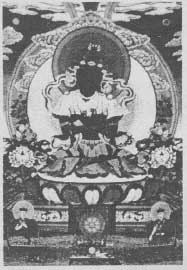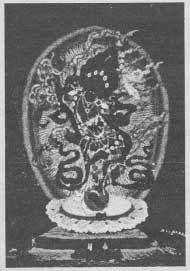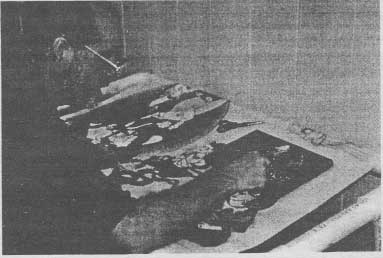| The following article is from the Spring, 1999 issue of the Snow Lion Newsletter and is for historical reference only. You can see this in context of the original newsletter here. |
by Russell Ellis
When I was arrested and sentenced on what I thought was going to be a minor drug conviction, I was shocked. Three years seemed like forever to me at that time (1975). I was 32 and wanted no part of prison. I felt like I was going to die.
To my surprise, I survived, and in fact found myself in a place where I could finally spend time on my religious practice, which I had always put on a back burner while on the streets. There was always something that seemed more important, so I became apart-time practitioner of Buddhism. At McNeil Island Federal Penitentiary, I found myself surrounded by what seemed to be hardened criminals mostly bank robbers. That was the most common crime of the inmates locked behind those walls. However, when I was sent to the camp outside the walls I found myself in the company of drug dealers and white-collar types.
I was given a job working at the dairy, where I milked 165 cows every morning and evening. The best part of the job was that I was now working with two Lakota Indians who had been sentenced for their part in the Wounded Knee incident of the early 70s. Wow! These were heroes of mine, as I was a strong sympathizer to their cause. I found them to be very respectful and strong and solid in their quiet demeanor. They spent much of their time beading on buckskin or on looms creating ceremonial garb. I was totally fascinated with this work and soon asked if they would teach me. Cheyenne Big Crow was the first one to take me seriously. He gave me a loom and showed me how to string it, then showed me a few traditional patterns. Before long, I found myself tiring of the limitations of the loom. I felt I wanted to do something more free-form something with motion, or curved lines at least. Big Crow then showed me how to bead on buckskin using the lazy man stitch. I really loved this form and became quite proficient in a short time. Big Crow then introduced me to Jeny Peltier, who is a relative of Leonard Peltier, the famous Indian activist. Jerry is a master beader of traditional rosettes, which are used on ceremonial garb and are used as symbols of different clans as well as certain teachings and history of the Lakota people. They are round beaded large buttons about three inches in diameter, though many are larger. They are beaded onto buckskin which is split very thin and is also very strong and supple. Anyway, I became a good technician and started studying the different ways of bleeding colors together to create different effects. All of the ceremonial/traditional beadwork is done with opaque beads and by now I was discovering that there were many other types of beads with more exciting finishes. I decided one day that I would like to do a picture because I could see the potential of mixing all of the different finishes to create a more realistic effect. Buckskin was too expensive to do a picture of any size so I decided to use canvas because we had a large supply of heavy-duty prison-made canvas at the camp and my friend could get me a large piece.
I was sitting in my cubicle a few days later wondering what kind of picture I should do. I looked over at a picture of a Buddhist thangka that a dear friend had sent me and it only seemed natural that I should do a religious piece. Since the beautiful Green Tara seemed to be saying, bead me, I decided to do just that. I wasn't sure how big it should be so I decided to do a small figure that was large enough to show the detail I felt a piece like that demanded. The figure I did was a Green Tara about eight inches high. With the clouds above and water below, it turned out to be about 12 inches high by 10 inches wide. When I finished it, I sent it to my teacher and he hung it on his wall and wrote back to me with a simple message to do this work. I had also asked him how to develop patience, so he told me to repeat something 108,000 times, which is a very typical Tibetan Buddhist idea. That was the final piece of the puzzle for me as to how large the picture should be. It would have to have at least 108,000 stitches. That equated to around 15 square feet. I started work on the thangka immediately. That was June of 1976. My Lakota friends were amazed that someone would be crazy enough to do a piece of beadwork that large. They would come by and sit on the bed next to me and watch me in silence as I beaded on my newly made wooden frame roller that could hold the canvas tightly so I could work. I didn't have any money and beads were relatively hard to come by because they had to be ordered and it could take months for an order to be processed, sent, and delivered back to the prison. I was making five dollars a month at the dairy. Soon after I started, a strange and truly wonderful thing started happening. I would come back from work and find a small package of beads sitting on my bed. There was never a note or explanation as to where they came from, but I soon realized it was my Lakota brothers giving the crazy white man the beads he would be needing as his work progressed. I never asked because there was this almost reverent knowing between us and I knew that they understood what the beautiful Tara thangka meant and that they were trying to help me bring it to expression in beads. They would come and sit and give me silent blessings and I would be doing my silent prayers as I beaded and we would sort of rest in the energy created by our mutual respect and love of the art. By the time I finished her, I estimate I recited the Tara mantra 3 to 4 million times. I was paroled in February of 1977 and had not finished the Tara yet, but I kept on working on her until she was finished. When I started I had no idea what I was getting myself into. My Lakota friends would only shake their heads and laugh in their knowing way they were not laughing at me, but with me in my ignorance and joy and zeal and enthusiasm. It took me two thousand hours to finish the first thangka. I have to admit that it took' 1500 of those hours to learn how to bead and by the time I was finished I was chomping at the bit to start the next one because there were so many things I had learned that I was dying to try on the next one. This work is so exhilarating to me! The blessings are amazing! I remember how I would, at first, spend a lot of time trying to figure out how to get certain effects, but when I would fall off to sleep after wondering I would often have vivid dreams in which I would see exactly how to create the effect I was hoping for' I don't know how to explain the things that obviously led me to this work and I realize now that the whys are not important anyway. I only know that when I sit down and bead I feel totally at ease and a serenity settles within me and I do not feel fatigue or anxiety or stress as to how it will look. There is a very mellow confidence and knowing that the work is the teacher and that I am within the blessings as I do it. I have so many stories of the transforming power of sharing the thangkas with others that are precious and exciting to me.
Anyway, on with the story. Between 1976 and 198-51 completed four thangkas. I did the Green Tara, a red Tara, another Green Tara, and a Prajnaparamita. Then in 19891 made another very stupid mistake and found myself back in federal prison for cultivation of marijuana this time with a ten-year sentence! I was shocked, depressed and outraged at myself for being so stupid. I was sure that my life was now totally ruined and that I would probably die there as my depression was so deep and my anger so consuming that I totally lost my ability to see anything but my own self-destructiveness; and I wore it proudly like a crown. Over the last four years I had gotten away from my religious practices and had gotten into the ego-gratification of making money growing pot and selling indoor growing equipment at which I was very successful. Now I found myself back in prison. The government took everything my family owned. My wife had left me and I was unable to contact my children. Guess what? It was time to wake up. The thing that woke me up the most was starting to bead again and do the work that my heart/mind knew in its deepest place was the work I was supposed to be doing.

Russell. Ellis's bead thangka of Vajradhara.

Vajrayogini

The artist working on a thangka of Vajradhara with consort.
I found myself at Terminal Island Penitentiary in Los Angeles. It was totally different from the relatively laid-back place the McNeil Island had been some thirteen years later. This was an overcrowded place1250 inmates in a prison designed for 490. The noise and violence were everywhere. It, like me, seethed anger. However, I found a shady place in the south yard at a table under a paint tree and started to bead there every day. Beads were still hard to get, but I managed to get enough to get started from inmates. As time passed there were people who appeared in my life who actually smuggled the beads into the prison to me. Believe it or not one was a Chinese Buddhist nun who came to teach Dharma! She just beamed when she dug the beads out of her robes and gave them to mealong with five pounds of organic brown rice and miso! There was also an inmate who was released who bought beads and made sure they were smuggled in to me without any cost to me. I am so blessed.
I would sit and bead and other inmates would come and sit at the picnic-style table and we would talk about the thangka and what it meant and the Dharma would be transmitted to another circle. I did a Heavenly White Tara and a Vajrayogini while at Terminal Island. There were several hundred young black gang-bangers at Terminal Island. These were tough young men raised up in the violent streets of South Central, Compton and all the tough inner city neighborhoods of LA. It was so awesome for me to talk to them about the teachings the thangka represented and then watch when, later, they would bring a friend back to see me work and sit there and explain to their friend the Dhanna the thangka stood forand in their own street lingo! And the most wonderful part of this was that they would get the message right, and then pass it on correctly too! That little picnic table under the palm was an oasis, a breath of fresh air, a true place of refuge and I was honored to witness all of the little acts of compassion and share the knowing.

Vajrayogini transmission was taking place and it was breathless and peaceful and safe and there was not the least hint of senseless violence. I believe [violence] would have been impossible at the special moment because all of our minds were stopped and we were all bathed in the non-compromising compassion of Vajrayogini.

Perhaps the most awesome story from Terminal Island was the day I finished the Vajrayogini. I let the word out that I was going to have the unveiling that night at seven o'clock. I figured that maybe a hundred, two hundred at the most, would show up for it. Well, by seven o'clock there were at least seven hundred of the twelve hundred men all crowded together in the corner of the south yard waiting for the unveiling. This so alarmed the guards that a detail of probably twenty of them came running into the yard just as I was unrolling the canvas. At that moment, the sun shined on Vajrayogini and she lit up all ablaze and I swear everything simply stopped. For a full minute or more there was silence and a deep reverence that we were all sharing something special. Vajrayogini transmission was taking place and it was breathless and peaceful and safe and there was not the least hint of senseless violence. I believe that would have been impossible at the special moment because all of our minds were stopped and we were all bathed in the non-compromising compassion of Vajrayogini. Over the 18 months I had worked on her, virtually everyone that lived or worked in the prison had passed by my table and spent time watching her being createdand knew that she was something sacred. I know that's why we all stopped and became one in compassion for that special moment. When it was over the police and inmates joined in a little celebration of appreciation of the beauty and then they left and we had a calm and joyous little party and welcomed her into our heart/minds. It was very profound.
In February of 1995,1 was shipped to camp in Florence, Colorado. When inmates get short, or close to getting out, they usually are sent to camp, which is a minimum-security facility where there are not walls or fences. There, they sort of decompress from the tension of the higher security prisons and get ready for the streets. In a way it is a reward for being a good inmate. Well, Florence was anything but a reward. The camp there furnishes inmates to work inside the ADX, which is the highest security prison in the world. It was like going into hell every day.
I would fluctuate between the ADX and my beading time at the camp. I spent nearly every spare minute working the Vajradhara thangka while I was at Florence. I finished it in late July of 1996 and was paroled in August of 1996. It too was a magnet for inmates to come and watch the progress. I worked in a small room known as the ait room, which was situated between the gymnasium and the weight room, the two most popular places in the camp besides the chow hall, so it was an easy place for them to pop into for a brief look and chat. 1 spent about 2000 hours on Vajradhara in a space of ten months, which equates to 50 hours per week. Plus, I was working at the ADX most of that time which was at least 40 hours per week. Florence was a blur of busyness and intensity, but Vajradhara is a symbol of complete serenity.
That's about it, except that I am now working on a Vajradhara with consort. It is very powerful and I hope to finish it by the middle of 1999 at the latest.
It is Mr. Ellis's goal to provide everyone the opportunity to view the thangkas. With exposure we're hoping the perfect buyer or institution will purchase the art and allow the thangkas to be exhibited throughout the country, allowing inner city youth, young adults in drug rehabilitation, and the general public the opportunity to experience the powerful healing and transformative qualities of Tibetan art.
Mr Ellis's dream is to use the proceeds from the sale of the art to establish a school for Native American beading, help jump-start a tour/exhibition of the thangkas for inner city youth, and to support the Tibetan community.
Contact Suzee Miller for interviews with Ellis or to purchase art, 800499-7844 [email protected]. To view additional photos see:
www.fengshuiparadigms.com under Referrals Russell C. Ellis

